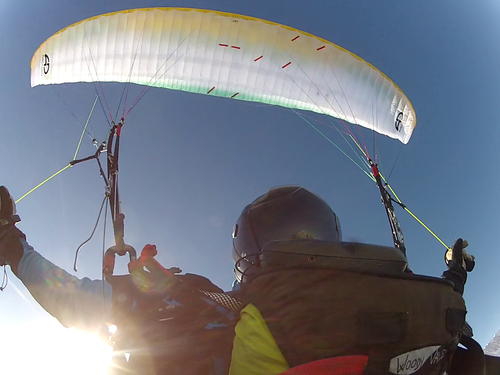Rise M |
|||||||||||||||||||||||||||||||||||||||||||||||||||||||||||||||||||||||||||||||||||||||||||||||||||||||||||||||||||||||||||||||||||||||||||||||||


|
|||||||||||||||||||||||||||||||||||||||||||||||||||||||||||||||||||||||||||||||||||||||||||||||||||||||||||||||||||||||||||||||||||||||||||||||||
Instability rating |
|||||||||||||||||||||||||||||||||||||||||||||||||||||||||||||||||||||||||||||||||||||||||||||||||||||||||||||||||||||||||||||||||||||||||||||||||
|
|||||||||||||||||||||||||||||||||||||||||||||||||||||||||||||||||||||||||||||||||||||||||||||||||||||||||||||||||||||||||||||||||||||||||||||||||
Glider characteristics |
|||||||||||||||||||||||||||||||||||||||||||||||||||||||||||||||||||||||||||||||||||||||||||||||||||||||||||||||||||||||||||||||||||||||||||||||||
|
Launch preparations: average
launch characteristics: dynamic, climbs constantly, no guidance necessary, good feedback during inflation, overshoots, pronounced braking required, control check simple, low takeoff speed
asymmetric collapse: canopy colllapses at high angle to leading edge, high dynamics, total course change 270-360°, (4), very fast course change rate, high forward pitching 75-90°, (5), pilot action required to end height loss (5), high sink velocity 20-24 m/s, (3), collapse on opposite wingtip with course change >90°, (5), with cravat, (5), G-Force 2,5- 2,9 G, (2)
Frontal collapse: canopy collapses with high total collapse aera, moderate pitch backwards 30-45°, moderate pitch forwards 30-45°, moderate dynamics, Continual rotation >360°, (5), variable recovery behaviour, at times with stable closed frontal collapse, at times with automatic recovery, (4), asymmetric recovery, advanced pilot action required, (5), horseshoe, wingtips at rear, with tendency to cravat, (4), Advanced pilot action required to end height loss (5), high sink velocity 20-24 m/s, (3)
Spiral dives: very rapid sink velocity increase, Moderate G-Force 3,5- 4.0 G, (2), Sink velocity after 720° <18 m/s, (3), High maximum sink velocity < 22 m/s, (3), sink velocity increase < 6 m/s on brake release, (2), Course change 360-540° after spiral exit, (3), moderate height loss during recovery 30-60 m, (2)
B-Stall: normal force required, moderate pitch backwards 15-30°, moderate pitch forwards 15-30°, unstable sink phase, high deformation tendency, tendency to cravat, immediate return to normal airspeed, 6-8 m/s, pilot action required to recover
big ears: simple initiation, stable flight phase, wingtips flatter a little, immediate automatic recovery, Vsink unaccelerated 2,5-3 m/s, Vsink accelerated 4-4,5 m/s, Vunaccelerated 3-5 km/h less than trimspeed, Vaccelerated >8 km/h faster than trimspeed
Steering behaviour: agile to dynamic |
|||||||||||||||||||||||||||||||||||||||||||||||||||||||||||||||||||||||||||||||||||||||||||||||||||||||||||||||||||||||||||||||||||||||||||||||||
Notes |
|||||||||||||||||||||||||||||||||||||||||||||||||||||||||||||||||||||||||||||||||||||||||||||||||||||||||||||||||||||||||||||||||||||||||||||||||
|
Launch characteristic: Climbs constantly and not too fast to the zenith, but needs more brake input to stop it there and stabilise the canopy. Asymmetric Collapse: Air Designs Rise had the most challenging behaviour to assymetric collapsing. Collapsing to the middle of the LTF norm field provoked reactions average for the class. As soon as the maximum end of the norm field is reached, the Rise then dives forward massively and cascades with a collapse on the opposite wingtip. Rapid course changes were noted and the cascade collapses cravated easily in the upper gallery lines. Recovering from the cravat was relativelyeasily done by applying a little brake, but had to be performed actively. The canopy folds steeply on collapsing which is always associated with more negative dynamicreactions in test results. Front collapses: Gliders in the LTF-A class generally do not have significant difficulties with front collapses. High end B class gliders generally have aspect ratios of 5.5 and more, and this leads to far more chaotic recove ry behaviour than what we see on compact gliders. Particularly chaotic reactions in this test were displayed by the Air Design Rise and the Icaro Wildcat TE.Both of these gliders do not self recover from front collapses which deform a moderate amount of depth from the leading edge. Pilot action is required to regain normal flight. Spiral Dive: The spiral test produced no great surprises.No glider demonstrated tendencies to remain in a stable dive after the brakes had been released to initiate recovery. High end B class gliders do tend to collapse on the outer wingtip when spiralling due to their higher aspect ratios. These small collapses produce sufficient resistance to prevent the gliders accelerating further in the spiral. Here all spirals were flown according to LTF test regulations without using weight shifting. Spirals flown in practice by pilots using weight shifting and stabilising the outer wingtip sufficiently to prevent it collapsing may well lead to further acceleration in the dive and produce a stable spiral dive once the brakes are released to initiate recovery. B-Stall: For even short B-stalls of <3 seconds, the wingtips on Air Designs Rise bend forward and cravat in the lines. It is only possible to achieve a stable B-stall here with a very careful dosed pull on the B- risers. Too much and the canopy deforms. Big Ears: Air Designs Rise also has relatively large areas which are collapsed at the wingtips. Inspite of the additional large resistance produced by the wingtips no deep-stall tendencies could be observed. Nevertheless, it is always a good idea to use the speed bar when applying this descent method. |
|||||||||||||||||||||||||||||||||||||||||||||||||||||||||||||||||||||||||||||||||||||||||||||||||||||||||||||||||||||||||||||||||||||||||||||||||
Rating |
|||||||||||||||||||||||||||||||||||||||||||||||||||||||||||||||||||||||||||||||||||||||||||||||||||||||||||||||||||||||||||||||||||||||||||||||||
|
Safety class 5 This class of paraglider reacts very demandingly to one or more of the following manoeuvres: frontal collapse, asymmetric collapse or spiral dive and may present pilots with a particular challenge.Very demandingly means that the above manoeuvres result in highly dynamic reactions from the glider, and/or large height losses. Critical subsequent glider reactions are also to be expected. Expert piloting skills achieved through constant practice, fast personal reaction times and precise pilot inputs are required to be able to immediately react to the above manoeuvres to maintain flight control and prevent large height loss or subsequent critical glider reactions. In particular, pilots should be able to recognise the onset of the above manoeuvres and be able to prevent or minimise their effects through immediate and precise pilot inputs. |
|||||||||||||||||||||||||||||||||||||||||||||||||||||||||||||||||||||||||||||||||||||||||||||||||||||||||||||||||||||||||||||||||||||||||||||||||

